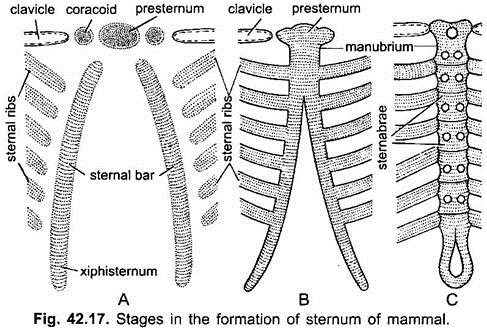The sternum is an elongated structure in the midvental region of the thorax. It is absent in fishes but occurs in tetrapoda. Some tetrapoda such as Proteus, Amphiuma, caecilians, snakes, turtles and limbless lizards have no sternum.
Primitively the sternum is a plate of cartilage, but in later forms it has a series of cartilages or bones or both. In tetrapoda the sternum articulates with the pectoral girdle. In amniotes (but not in amphibians) it also articulates with ribs to form a thoracic basket which is protective and aids in breathing.
The origin of a sternum is obscure.
It is explained by three main theories:
ADVERTISEMENTS:
1. The median portions of two pectoral girdles united midventrally to form a sternum.
2. The ventral ends of the more anterior ribs fuse to form a rod of cartilage on each side. The two rods then unite to form a sternum. Such a sternum is called a neosternum and is found in amniotes. Objection to this theory is based on the presence of a sternum in most amphibians, but in no case are ribs associated with it.
3. Cartilages called parasternals, which are the same as abdominal ribs, develop in the ventral myocommata of the thoracic region in many amphibians and lizards. Some of the anterior parasternals fuse to form a sternum, such a sternum is called an archisternum. This theory is regarded as the most probable.
ADVERTISEMENTS:
In mammals the mesenchyme condenses mid-ventrally between the pectoral girdles. This mesenchyme chondrifies to form a presternum cartilage. Posterior to it two elongated bars of cartilage arise, they unite with each other medially and fuse with the presternum. They also unite with the ribs laterally. The central part of the bars joining the ribs becomes the mesosternum, while its free posterior end is the xiphisternum, later the cartilage ossifies.
a. Pisces:
Sternum is lacking.
b. Amphibia:
ADVERTISEMENTS:
The sternum is in two parts- anterior to the clavicles lies an inverted Y-shaped bony omosternum with expanded cartilaginous episternum in front. Posterior to the coracoids is a bony sternum proper or mesosternum having an expanded cartilaginous xiphisternum posteriorly. Sternum is absent in caecilians, Amphiuma and Proteus. The homology of such a sternum with that of amniotes is doubtful.
c. Reptilia:
The sternum is a rhomboidal plate of cartilage between the coracoids. The sternal parts of three pairs of thoracic ribs are attached to it. A T-shaped dermal bone, the episternum (interclavicle) lies ventral to the sternum, but it is not a part of the sternum. A sternum is absent in turtles, snakes, and most limbless lizards.
d. Aves:
The sternum has a broad triangular bone extending far posteriorly below the abdomen. The mid-ventral portion is drawn out into a carina or keel in flying birds for insertion of large muscles of flight. It forms a T-shaped girder to bear the weight of the heavy abdominal viscera. Projecting anteriorly is a pair of costal processes to which thoracic ribs are attached. Posterolaterally are two pairs of xiphoid processes. Running birds have a rounded sternum with no keel. Extinct flying reptiles have a carinate sternum.
e. Mammalia:
The sternum is made of a series of bones fixed together and arranged in a row lying mid-ventrally in the thorax. It has become segmented secondarily and has three regions- an anterior presternum (manubrium), middle mesosternum consisting of five pieces or sternebrae, the fifth is very small, and a posterior region called metasternum (xiphisternum), which is long and has a terminal expanded xiphoid cartilage. Seven pairs of ribs are joined to the sternum in such a way that each rib articulates with two sternebrae. Bats have carinate sternum.
